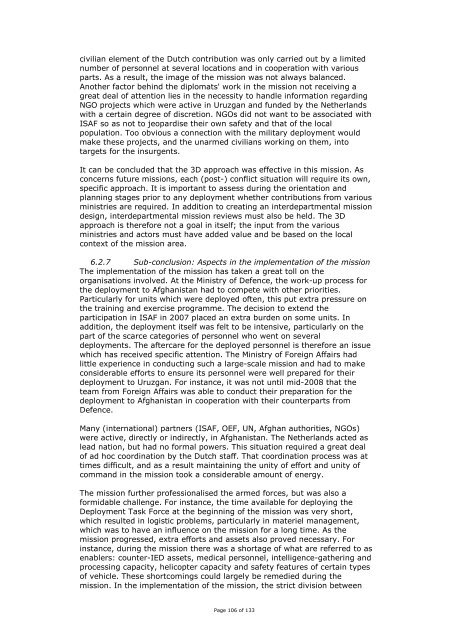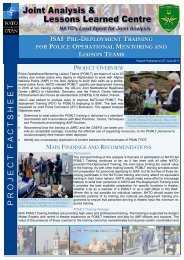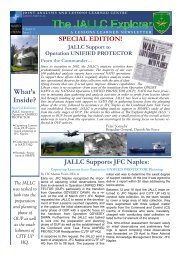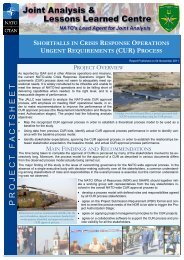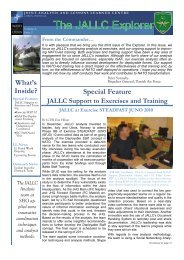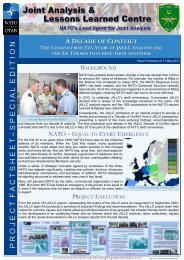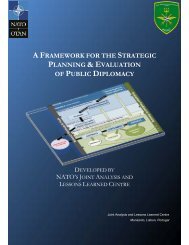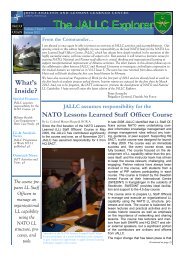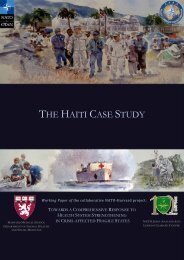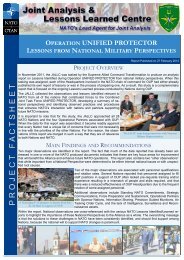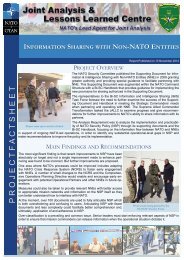civilian element of the Dutch contribution was only carried out by a limitednumber of personnel at several locations and <strong>in</strong> cooperation with variousparts. As a result, the image of the mission was not always balanced.Another factor beh<strong>in</strong>d the diplomats' work <strong>in</strong> the mission not receiv<strong>in</strong>g agreat deal of attention lies <strong>in</strong> the necessity to handle <strong>in</strong>formation regard<strong>in</strong>gNGO projects which were active <strong>in</strong> Uruzgan and funded by the <strong>Netherlands</strong>with a certa<strong>in</strong> degree of discretion. NGOs did not want to be associated with<strong>ISAF</strong> so as not to jeopardise their own safety and that of the localpopulation. Too obvious a connection with the military deployment wouldmake these projects, and the unarmed civilians work<strong>in</strong>g on them, <strong>in</strong>totargets for the <strong>in</strong>surgents.It can be concluded that the 3D approach was effective <strong>in</strong> this mission. Asconcerns future missions, each (post-) conflict situation will require its own,specific approach. It is important to assess dur<strong>in</strong>g the orientation andplann<strong>in</strong>g stages prior to any deployment whether contributions from variousm<strong>in</strong>istries are required. In addition to creat<strong>in</strong>g an <strong>in</strong>terdepartmental missiondesign, <strong>in</strong>terdepartmental mission reviews must also be held. The 3Dapproach is therefore not a goal <strong>in</strong> itself; the <strong>in</strong>put from the variousm<strong>in</strong>istries and actors must have added value and be based on the localcontext of the mission area.6.2.7 Sub-conclusion: Aspects <strong>in</strong> the implementation of the missionThe implementation of the mission has taken a great toll on theorganisations <strong>in</strong>volved. At the M<strong>in</strong>istry of Defence, the work-up process forthe deployment to Afghanistan had to compete with other priorities.Particularly for units which were deployed often, this put extra pressure onthe tra<strong>in</strong><strong>in</strong>g and exercise programme. The decision to extend the<strong>participation</strong> <strong>in</strong> <strong>ISAF</strong> <strong>in</strong> 2007 placed an extra burden on some units. Inaddition, the deployment itself was felt to be <strong>in</strong>tensive, particularly on thepart of the scarce categories of personnel who went on severaldeployments. The aftercare for the deployed personnel is therefore an issuewhich has received specific attention. The M<strong>in</strong>istry of Foreign Affairs hadlittle experience <strong>in</strong> conduct<strong>in</strong>g such a large-scale mission and had to makeconsiderable efforts to ensure its personnel were well prepared for theirdeployment to Uruzgan. For <strong>in</strong>stance, it was not until mid-2008 that theteam from Foreign Affairs was able to conduct their preparation for thedeployment to Afghanistan <strong>in</strong> cooperation with their counterparts fromDefence.Many (<strong>in</strong>ternational) partners (<strong>ISAF</strong>, OEF, UN, Afghan authorities, NGOs)were active, directly or <strong>in</strong>directly, <strong>in</strong> Afghanistan. The <strong>Netherlands</strong> acted aslead nation, but had no formal powers. This situation required a great dealof ad hoc coord<strong>in</strong>ation by the Dutch staff. That coord<strong>in</strong>ation process was attimes difficult, and as a result ma<strong>in</strong>ta<strong>in</strong><strong>in</strong>g the unity of effort and unity ofcommand <strong>in</strong> the mission took a considerable amount of energy.The mission further professionalised the armed forces, but was also aformidable challenge. For <strong>in</strong>stance, the time available for deploy<strong>in</strong>g theDeployment Task Force at the beg<strong>in</strong>n<strong>in</strong>g of the mission was very short,which resulted <strong>in</strong> logistic problems, particularly <strong>in</strong> materiel management,which was to have an <strong>in</strong>fluence on the mission for a long time. As themission progressed, extra efforts and assets also proved necessary. For<strong>in</strong>stance, dur<strong>in</strong>g the mission there was a shortage of what are referred to asenablers: counter-IED assets, medical personnel, <strong>in</strong>telligence-gather<strong>in</strong>g andprocess<strong>in</strong>g capacity, helicopter capacity and safety features of certa<strong>in</strong> typesof vehicle. These shortcom<strong>in</strong>gs could largely be remedied dur<strong>in</strong>g themission. In the implementation of the mission, the strict division betweenPage 106 of 133
<strong>ISAF</strong> and the OEF led to extra coord<strong>in</strong>at<strong>in</strong>g measures, both for the TFU andthe ATF.The <strong>Netherlands</strong> followed the <strong>in</strong>ternational guidel<strong>in</strong>es regard<strong>in</strong>g thetreatment of Afghan deta<strong>in</strong>ees dur<strong>in</strong>g the mission. In 2005, agreementswere made with the Afghan authorities <strong>in</strong> this matter, particularlyconcern<strong>in</strong>g the Dutch monitor<strong>in</strong>g regime and unlimited access to thedeta<strong>in</strong>ees for Afghan NGOs, <strong>in</strong>ternational organisations and the embassy.This Memorandum of Understand<strong>in</strong>g proved its worth.The <strong>Netherlands</strong> ma<strong>in</strong>ly made use of direct contracts with localorganisations and, through them, companies. Hav<strong>in</strong>g a cha<strong>in</strong> of severalsub-contractors was avoided where possible. The f<strong>in</strong>ancial reports were alsochecked thoroughly <strong>in</strong> order to combat corruption and fraud. In a fragileenvironment with weak <strong>in</strong>stitutions and limited monitor<strong>in</strong>g possibilities,irregularities (nepotism, over-<strong>in</strong>voic<strong>in</strong>g, fraud, corruption etc.) could not befully ruled out. In this context, the monitor<strong>in</strong>g of activities cont<strong>in</strong>ued to be achallenge. For that reason, the embassy created a specific framework for<strong>in</strong>direct monitor<strong>in</strong>g of the activities <strong>in</strong> the prov<strong>in</strong>ce of Uruzgan. For <strong>in</strong>stance,external, <strong>in</strong>dependent parties were <strong>in</strong>volved <strong>in</strong> the monitor<strong>in</strong>g of output andimpact of the <strong>in</strong>terventions. This had a positive effect.The civil assessment which was conducted at the beg<strong>in</strong>n<strong>in</strong>g of the missionwas very useful <strong>in</strong> the further implementation of the mission, particularlybecause it provided a great deal of <strong>in</strong>formation <strong>in</strong> the social and civilsituation <strong>in</strong> the prov<strong>in</strong>ce.6.2.8 Sub-conclusion: Expenditure for the missionThe additional expenditure for the Dutch contribution to <strong>ISAF</strong> amounted toEUR 1.99 billion for the <strong>2006</strong>-2011 period. Most of this, EUR 1.6 billion, wasfunded from the Homogeneous Budget for International Cooperation(HGIS). The rema<strong>in</strong><strong>in</strong>g EUR 390 million came from the <strong>in</strong>vestment andread<strong>in</strong>ess budget of the M<strong>in</strong>istry of Defence and is related to various budgetadditions.Of the HGIS-funded expenditure, EUR 1.22 billion can be ascribed to thecosts of the deployment of the armed forces <strong>in</strong> Afghanistan. This is asignificantly greater amount than had been expected and this discrepancyma<strong>in</strong>ly related to the first two years. When the mission was extended <strong>in</strong>late 2007, an estimate was drawn up which was better aligned with theexpenditure.There is a significant discrepancy between the <strong>in</strong>itial estimates and theactual expenditure funded by the HGIS. When the <strong>in</strong>itial estimate wasdrawn up <strong>in</strong> 2005, there was little <strong>in</strong>sight <strong>in</strong>to what actual expenses therewould be, related to the deployment of the armed forces as lead nation <strong>in</strong>Uruzgan. No f<strong>in</strong>ancial room was budgeted for significant unforeseenexpenditure. Due to operational requirements and changes <strong>in</strong> theparameters of the mission, however, there were <strong>in</strong>deed unforeseenexpenses. Examples are the <strong>in</strong>crease <strong>in</strong> personnel numbers and the hir<strong>in</strong>gof unmanned aircraft.In pr<strong>in</strong>ciple, the HGIS system only accommodates additional expenditurefor the Defence organisation if it is related to a mission. Capital <strong>in</strong>vestmentsand runn<strong>in</strong>g costs that are part of the day-to-day runn<strong>in</strong>g of theorganisation are not funded by the HGIS. The rules can foster <strong>in</strong>efficientuse of government funds. These efficiency considerations were taken <strong>in</strong>toaccount with regard to the expenditure for the armed forces’ <strong>participation</strong> <strong>in</strong>Page 107 of 133
- Page 1 and 2:
Final evaluationNetherlands contrib
- Page 3 and 4:
High mountainsLow mountainsPlains a
- Page 5 and 6:
Table of ContentsDutch military per
- Page 7 and 8:
Dutch military personnel deceased i
- Page 9 and 10:
Page 9 of 133
- Page 11 and 12:
1 IntroductionThe government would,
- Page 13 and 14:
The structure of the final evaluati
- Page 15 and 16:
2 The international presence in Afg
- Page 17 and 18:
insurgents in, particularly, the ea
- Page 19 and 20:
3 Netherlands policy for participat
- Page 21 and 22:
Netherlands’ presence. Furthermor
- Page 23 and 24:
“The objectives of this stabilisa
- Page 25 and 26:
In December 2005, the Netherlands g
- Page 27 and 28:
The expectation is that meaningful
- Page 29 and 30:
3.6.2 Implementation of national pr
- Page 31 and 32:
4 Implementation of the mission and
- Page 33 and 34:
tasks to fulfil in the area of secu
- Page 35 and 36:
such as the Bushmaster, that was be
- Page 37 and 38:
Afghan partner unit, at all times o
- Page 39 and 40:
northern part of Deh Rawod in 2007.
- Page 41 and 42:
in large and small bases, while con
- Page 43 and 44:
previously thought and comprised a
- Page 45 and 46:
Apart from facilitating training an
- Page 47 and 48:
If operations in close proximity of
- Page 49 and 50:
As previously mentioned, the preven
- Page 51 and 52:
- Between 2006 and 2010, the number
- Page 53 and 54:
government of Chora in January 2010
- Page 55 and 56: At the beginning of the Dutch missi
- Page 57 and 58: intermediary of TLO and political a
- Page 59 and 60: interest for filling judicial posit
- Page 61 and 62: During the Uruzgan mission, a great
- Page 63 and 64: structurally change governance in U
- Page 65 and 66: development programmes. Before the
- Page 67 and 68: also the way in which Afghans perce
- Page 69 and 70: tailored to the real needs of the p
- Page 71 and 72: Gizab had increased and there was a
- Page 73 and 74: The DCU programme devoted and still
- Page 75 and 76: purpose of these loans, cooperative
- Page 77 and 78: In view of the lack of enthusiasm a
- Page 79 and 80: 5 Expenditure for the mission and i
- Page 81 and 82: Overview of long-term expenditure a
- Page 83 and 84: expenditure related to the deployme
- Page 85 and 86: Multi-year expenditure, Foreign Aff
- Page 87 and 88: explosive ordnance disposal, armour
- Page 89 and 90: this situation as constraining, for
- Page 91 and 92: organised at a later stage. In addi
- Page 93 and 94: occupational social workers and the
- Page 95 and 96: Mercedes Benz terrain vehicle, the
- Page 97 and 98: 6 ConclusionsThis chapter begins wi
- Page 99 and 100: The first part of the central quest
- Page 101 and 102: At the end of 2005, the Afghan auth
- Page 103 and 104: province. This, too, was done by me
- Page 105: area, increased sales of agricultur
- Page 109 and 110: d. The recommendations from advisor
- Page 111 and 112: Page 111 of 133
- Page 113 and 114: Annex A, Afghanistan Compact Benchm
- Page 115 and 116: end-2010, reforms will strengthen t
- Page 117 and 118: Afghan Cultural HeritageA comprehen
- Page 119 and 120: Private Sector Development and Trad
- Page 121 and 122: Annex B, Results of the socio-econo
- Page 123 and 124: EducationTLO data:• In 2006 there
- Page 125 and 126: Overview of the number of children
- Page 127 and 128: Annex C, Chronology200522 December:
- Page 129 and 130: July: microcredit provider World Co
- Page 131 and 132: Annex D, List of abbreviations3DADZ
- Page 133: Page 133 of 133


